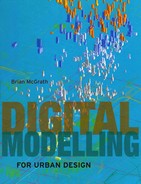Book Description
While there is a rich array of urban theory, design, and representation books available, there is currently no book which brings together, in a single volume, urban design theory and new digital technologies in urban information mapping, modeling, and 3D simulation. Based on two decades of practicing and teaching architecture, author Brian McGrath's Digital Modelling for Urban Design explores the new theories and technologies of digital modelling, focusing on how to create moving and interactive 3D drawing, skills useful in the context of urban theory, and design and representation. Fully illustrated with original maps, 3D models, and drawings and photographs, this innovative work introduces digital modelling to students, architects, designers, and planners interested in the processes key to shaping the urban environment.
Table of Contents
- Cover Page
- Title Page
- Copyright
- Dedication
- Table of Contents
- Prelude: Digital Modelling for Urban Design
- Introduction: The Spectacularisation of Urban Design
- Chapter 1: Archaeology
- 1985–95: Transparent Cities
- 1995–2005: An Archaeology of Globalisation
- From Transparent Cities to Archaeological Modelling
- 1893–1901: Forma Urbis Romae
- 1915–28: The Iconography of Manhattan Island
- 1890–1932: The Geo-body of Bangkok
- Assembling New Urban Design Models
- Collateral Space
- Correlative Space
- Complementary Space
- Multiplicities and Seriality
- Chapter 2: War
- 1801–1803: The Emergence of Scientific Archaeology
- 50 BC – AD 203: Modelling the Spoils of War
- Urban Design as Triumphal Model
- 300–1300: The Recycling City Model
- Churches: The New Urban Artefacts
- 1300–1944: Urban Design as Representation and Destruction
- The Dispersed City Model
- Destructions and Dispersals
- Chapter 3: Genealogy
- Chapter 4: Trade
- Chapter 5: Schizoanalysis
- Chapter 6: Desire
- Conclusion: Modelling Urban Design Futures in India and China
- Glossary
- Index
- Photographic Credits
